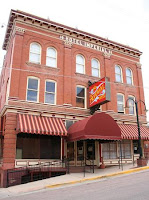This is a legend that has
persisted in Chihuahua, Mexico for 86 years. People from all over the world
have come to this town to see a mannequin that stands in the front window of a
bridal shop.
 |
| Pascuala Esparza |
Pascuala Esparza, who owned
this shop, had a beautiful young daughter. Tragically, she died on her wedding
day from a Black Widow bite.
Soon after this death, Esparza’s
shop displayed a new mannequin in the shop’s window. It wasn’t long before the
residents of Chihuahua began to be concerned.
It was noted this mannequin
held an uncanny resemblance to Esparza’s daughter. Even more disturbing the
form had a life-like appearance. The face has wide expressive eyes with a
fresh blushed skin tone. The hands, in particular, looked real with nails on the fingers and lifelines
on the palms.
 |
| The mannequin. |
The locals began to refer to
the form as La Pascualita meaning
little Pascuala or “her daughter.”
The hair on this form also
appeared real.
Rumors began that this form
was actually the preserved or embalmed corpse of Esparza’s daughter. Many of
the local residents now looked upon Pascuala Esparaza with stern disapproval.
This grieving mother
flabbergasted by these rumors tried to deny them, but no one would listen. By
this time rumors began to be spread that there was something even stranger
about this mannequin.
People passing by the shop
claimed the form eerily followed them with its eyes. Others in the shop mentioned
the mannequin’s eyes appeared to follow their every move.
Employees at the shop stated
that often when they returned to work in the morning they found the mannequin
had changed positions in the window.
One wild rumor stated that a
French magician smitten by the beauty of the mannequin fell in love. It was
said he approached the window at night, where he brought the form back to life, and
then he would take her “out on the town.”
Even today, some still believe this mannequin is a real human corpse. This belief was given
credence when a more recent employee, Sonia Burciaga who is tasked with
changing the bridal gowns on this form stated she doesn’t like touching it.
She mentioned that the figure even has varicose veins on its legs.
A taxi driver who often
brings tourists to the shop to see this mannequin in downtown Chihuahua states
that he has seen this form change positions as he circles the shop in his car.
Other witnesses still report
seeing it watch them or change positions.
Some believe this figure is a
saint and they leave offerings for it at the shop.
In recent years, several people disturbed about this story—state there is no way a corpse
could be preserved in this state for so long--an obvious point.
With research one discovers
this mannequin is made of wax—which accounts for its life-like appearance.
Keep in mind this story is a
“legend.” Legends are told for entertainment, they spice life up.
Logically, no one would buy a
wedding gown that had been displayed on an embalmed corpse. But this bridal
shop has gotten a lot of free publicity over the years.






























